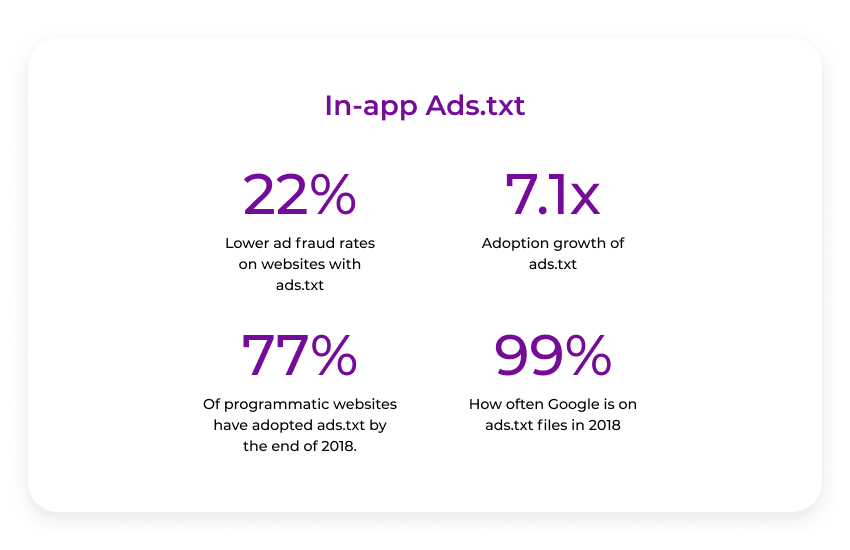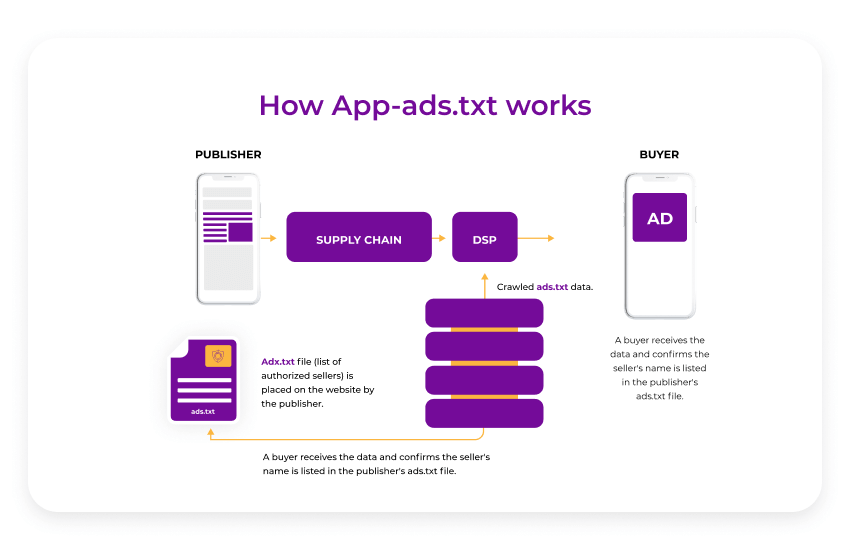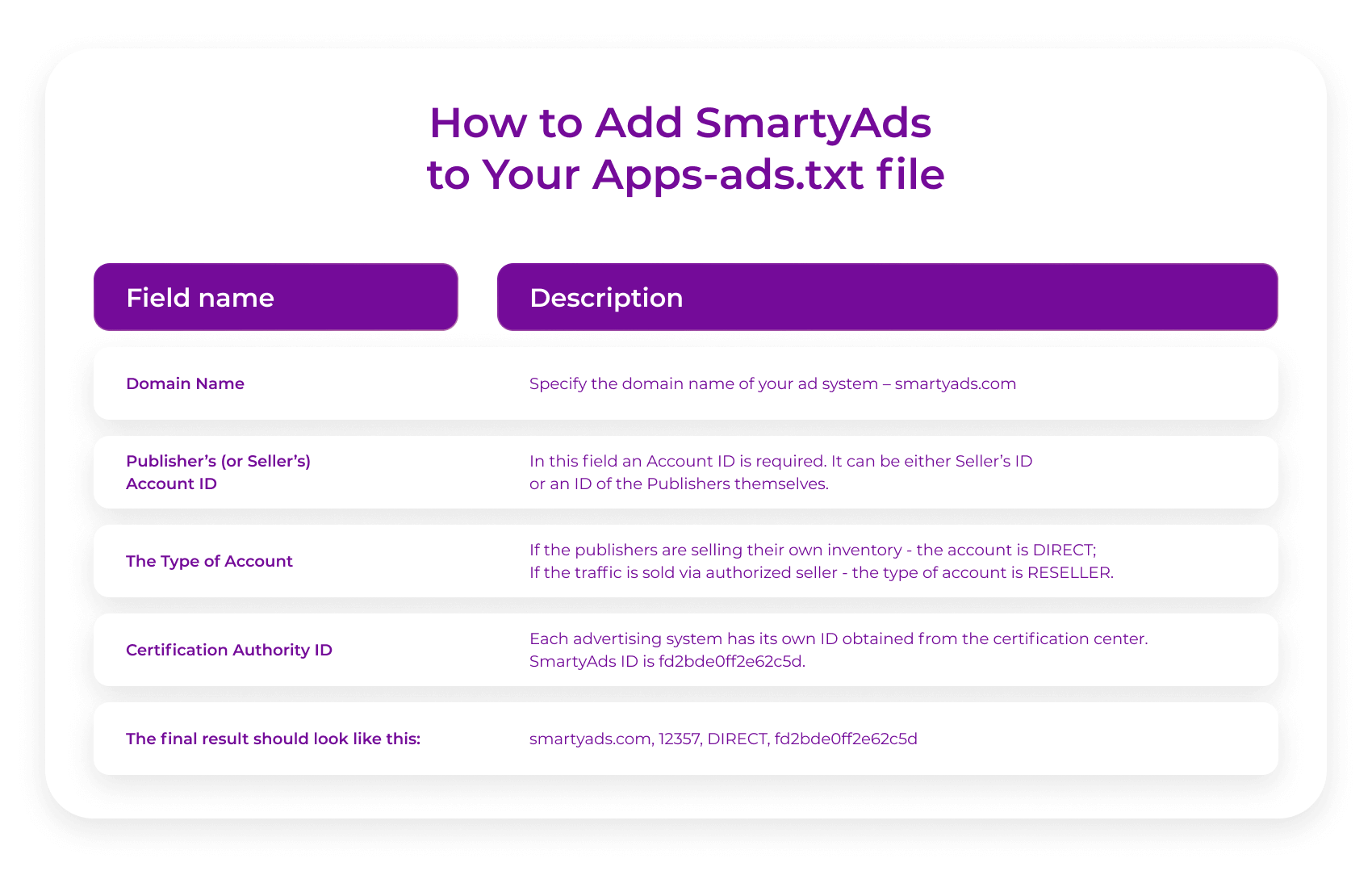Excellent news, everyone! On March 13, 2019, the IAB Tech Lab’s OpenRTB working group is finally releasing app-ads.txt standard designed for CTV and mobile in app advertising. It is an extension of ads.txt for in-app standard dedicated to protecting the programmatic industry from domain impersonation and illegal inventory sales.
It is estimated that in 2018 about $19 billion of the total ad spend was wasted due to ad fraudsters. Of course, the introduction of the app ads.txt won’t combat this issue at once, but it is an enormous leap on the way to reducing these losses. The faster such a standard is implemented by mobile publishers, the bigger the chances that such waste won’t occur in the future.
With all that in mind, let us now inspect what is app-ads.txt and how it can benefit publishers and advertisers.
What is mobile app ads.txt?
Or rather what is ads.txt for mobile? Perhaps the easiest way to explain what is in app ads.txt is to say that it is the standard similar to ads.cert and ads.txt. The difference is, that it is made for mobile and OTT advertising verification. It is a file that lists the IDs of legitimate sellers of mobile and CTV inventory in order to prevent scams and protect the industry from ad fraudsters. Advertisers can then check out these files to ensure that the sellers are actually approved by the publisher to offer the inventory. This way, thanks to a simple mobile ads.txt file, scammers are eliminated from the supply chain, and the advertisers are bidding on real inventory from real publishers only.

Why Not Just Use Ads.txt?
Usually, web-based and app-based inventory are considered two different inventories. When it comes to the usage of ads.txt, in app and OTT publishers have nothing to do with the inventory sold on websites. Meanwhile, both types are vulnerable to inventory fraud, so creating two separate files for each inventory type is a good option to ease sellers authorization and increase transparency. Given that CTV and mobile advertising spend gets overwhelming with each passing year, it is important to prevent ad fraud losses beforehand.

Why Implement app-ads.txt?
We now know what app ads.txt is and how it differs from ads.txt, but why would you implement it? Apart from overall benefits for the industry, there are several reasons for publishers to include the app-ads.txt list to their websites:
- Prevention of ad fraud. We already mentioned this one earlier, but it is hard to underestimate the importance of this goal. Scammers can impersonate legitimate publishers by forging apps and OTT inventory in order to steal their rightful revenue. With app-ads.txt, in app and CTV advertisers can distinguish real publishers from fake ones so they get inventory through fair programmatic deals.
- Protect the brand reputation. Publishers who care about their brand reputation should also turn their attention to the in app ads.txt. The verification of authorized sellers is also vital for advertisers who can otherwise spend their money and receive no impressions. Such accidents will certainly negatively impact the relationships between the supply and demand sides. Adopting new standards, thus, would help to maintain trust and transparency.
- Standard supported by Google. Starting from August 27, 2019, Google will block ads from unauthorized sellers, so the adoption of this standard will help publishers to stay valid for buyers and protect their incomes long-term. Therefore, the SmartyAds team recommends app developers and OTT publishers to support this initiative and create in-app ads.txt as soon as possible.
How Does App-ads.txt Work?
The concept of app-ads.txt is similar to that of ads.txt and can be described in 3 simple steps:
Step 1. The publishers create a mobile ads.txt file containing information about authorized sellers and upload it to their developer website within the root of their domain. It is also expected that the app stores will connect the app to the sellers list, so it’s important to also register the URL with the file on your app stores. The mobile ads txt file should have a path “domain.com/app-ads.txt” and include the following information about each seller:
- Seller’s domain name
- Publisher or Seller ID
- Type of relationship between seller and publisher
- Ad source ID
Step 2. Publisher’s inventory enters the supply chain and the ad exchange. DSP scans the txt app file to make sure the offer comes from one of the authorized sellers.
Step 3. If everything is fine, a bid request is accepted and the inventory is sold to the interested advertisers.

SmartyAds supports IAB Tech Lab’s app-ads.txt
At SmartyAds we always do our best to be at the forefront of the innovations, and we believe that app-ads.txt adoption is crucial for every member of the industry. Registration of authorized sellers will increase media-trading transparency and make the programmatic ecosystem a better and safer place, which has always been a greatest mission for our company.

How to add SmartyAds to your apps-ads.txt file
The whole process of integrating SmartyAds SSP to the mobile txt file is straightforward and shouldn’t take you more than several minutes.
1) Enter SmartyAds SSP dashboard and open the ‘Inventory’ section. Next, download your txt app file via 'Get ads.txt' link:
.png) 2) Once you’ve got your mobile txt file, add it to the root directory of your website. If you already have an app-ads.txt file on your site, just copy the content and add it to the existing app-ads.txt file on a new line. The content needs to meet the requirements listed in the table below:
2) Once you’ve got your mobile txt file, add it to the root directory of your website. If you already have an app-ads.txt file on your site, just copy the content and add it to the existing app-ads.txt file on a new line. The content needs to meet the requirements listed in the table below:

Conclusions
The implementation of txt app file helps to distinguish legitimate supply sources from fake ones. Without the extension of ads.txt to mobile, brands may lose billions on mobile ads each year because of unauthorized reselling, arbitrage, or domain spoofing. It is especially valid for ad inventory that is sold in open marketplaces. Implementing app-ads.txt to mobile inventory, app publishers not only protect their mobile revenues but also make a step towards greater transparency and safety of programmatic media trading.

.webp)


